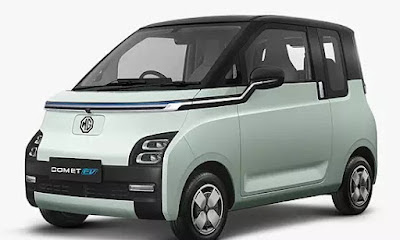After a year of driving the MG Comet electric vehicle (EV), it’s time to reflect on its performance, comfort, and overall value.
The MG Comet has made a notable impression in the electric vehicle space, particularly for urban commuters.
 |
| MG Comet EV, with its limited range of 250 km on a single charge, is ideal for city driving only. |
Here’s an in-depth review that covers the pros and cons of this compact electric vehicle.
Design and comfort
Sleek and modern aesthetics
The MG Comet EV boasts of a modern design that catches the eye. Its compact size makes it ideal for city driving, while the unique styling ensures that it stands out in a crowded parking lot.
The interior features a clean, minimalist layout, with comfortable seating for up to four passengers.
The materials used in the cabin are generally high quality, providing a sense of durability and sophistication.
Spacious yet compact
One of the surprising aspects of the MG Comet EV is its spaciousness.
Despite its small footprint, the cabin feels airy, thanks to large windows and a well-thought-out design.
The rear seats may be a bit snug for tall passengers, but they are adequate for short trips. The boot space, while limited, is sufficient for everyday use.
Smooth driving experience
Over the past year, the MG Comet EV has proven to be a reliable and smooth performer.
The electric motor delivers instant torque, making acceleration effortless, particularly under city driving conditions.
The vehicle handles well around corners, with a tight turning radius that enhances maneuverability in urban environments.
Adequate range for daily use
With a range of approximately 250 km on a single charge, the MG Comet EV is well suited for daily commutes.
For city dwellers, this range is more than enough to cover normal distances. However, those who frequently embark on longer journeys may find themselves needing to recharge more often than they’d like.
Technology and features
User-friendly infotainment system
The MG Comet EV comes equipped with a touchscreen infotainment system that is intuitive and easy to navigate.
Other tech features
Features such as Bluetooth connectivity, smartphone integration, and navigation are standard, enhancing the overall driving experience.
The sound system is decent, providing adequate audio quality for everyday listening.
Safety features
Safety is a priority in the MG Comet EV, with various features designed to protect occupants.
Standard safety equipment includes multiple airbags, ABS, and stability control.
However, some advanced driver-assistance systems that are becoming common in newer models are notably absent.
Pros and cons
Pros
Eco friendly: As an electric vehicle, the MG Comet EV produces zero emission, making it an environmentally-friendly choice.
Compact size: Its small dimensions make it perfect for navigating busy city streets and fitting into tight parking spots.
Cost effective: With low running costs and government incentives for electric vehicles, the MG Comet EV is a financially-smart choice.
Stylish design: The modern aesthetics and unique styling help it stand out from other compact cars.
Cons
Limited range: While adequate for daily commutes, the 250-km range may be insufficient for long-distance travel.
Rear seat space: The back seats may be cramped for tall passengers, making it less suitable for larger families.
Lack of advanced safety features: The absence of certain driver-assistance technologies can be a drawback for those seeking the latest safety advancements.
To estimate the costs of driving, charging, battery swapping, and other expenses for an MG Comet over one year, let’s break it down into components:
Cost break-up of MG Comet EV after one year
Driving cost: Assuming one drives about 12,000 km a year and the MG Comet has an efficiency of around 15 kWh per 100 km, the total energy consumption would be:
Total energy consumption = 12,000 km × 15 kWh/100 = 1,800 kWh
Charging cost: Let’s assume the average cost of electricity is about Rs 7 per kWh.
Total charging cost = 1,800 kWh × Rs 7/kWh = Rs 12,600
Battery swapping cost: If battery swapping is available and costs around Rs 300 per swap, and assuming you swap once a month:
Total battery swapping cost = Rs 300 × 12 swaps = Rs 3,600
Other costs: These might include maintenance, insurance and road tax. Assuming these are around Rs 10,000 for a year.
Total cost after one year:
Driving cost: Rs 12,600
Battery swapping cost: Rs 3,600
Other costs: Rs 10,000
Total cost = Rs 12,600 + Rs 3,600 + Rs 10,000 = Rs 26,200
E-Vroooom’s views
MG Comet EV’s stylish design, smooth performance, and affordability make it an attractive option in the electric vehicle market.
While it may have some limitations, particularly regarding range and rear passenger comfort, its benefits significantly outweigh the drawbacks for city commuters.
After a year of use, the MG Comet EV proves to be a solid choice for urban drivers seeking an eco-friendly vehicle.

No comments:
Post a Comment